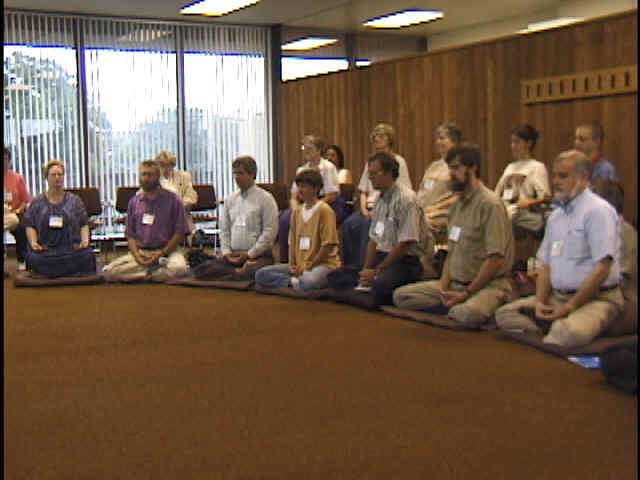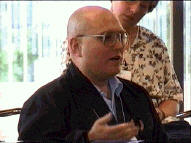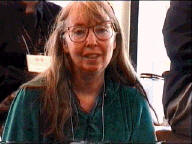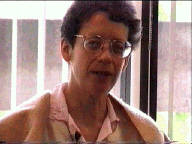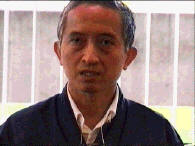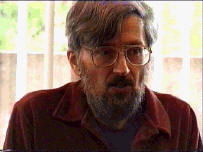|
Online
Transcript:
Susan Postal
I have been involved in Buddhist practice since 1969 or 70, first in the Tibetan
tradition for ten years, and then in Zen since 1980, studying first with Glassman at the
Zen community center in New York, and then in 1987 I began studying with the late Maureen
Stuart in Cambridge, Maureen ordained me at the Meeting House which actually was opened as
a sitting place with Glassman - our little zendo. So since 1986 I’ve had the great
pleasure of using a Quaker Meeting House in Rye which is an antique church built in the
1830s. Since her death in 1990 people started to arrive - really fine students. Zazen does
us. That happens quite naturally. In my other life I am a director of activities in a
nursing home. At our zendo all we own are cushions. We have $200 in the back, and
that’s fine. My teacher was something of a maverick, and I seem to be her daughter.
Wisdom and compassion in Buddhism are so intimately linked. Prajna Karuna is sometimes
described as two wings of the bird. We can’t seem to fly in the life of the Buddha if
we don’t have prajna (wisdom) and karuna (compassion). Sometimes it is seen not just
as wings of the bird, but also as prajna - as the ignition of wisdom that is like the
lighting of a candle, and then compassion is the light that comes from that. So there is
this intimate connection between wisdom and compassion.
The bodhisattva ideal is to be fully engaged as practitioners insofar as we have any
sense of aim or direction. Even though there is nothing to be gained, it is to become a
servant.
Becoming clear enough to see and respond. The wisdom of clear seeing has likened this
wisdom to a clear mirror that reflects completely impartially whatever appears. The mirror
shows us flowers, and shows us shit, and there is no difference. The mirror doesn’t
have that uncomfortable feeling that I had when I said that word, and maybe you had when
you heard it. We are uncomfortable, but mirror-mind just reflects. Buddhist teachings so
often give us a picture of something that is so hard to describe, so mirror for wisdom is
a wonderful kind of image. Dogen had a poem where he uses a wind bell that just rings -
impartially - like a great mouth - just ringing, and if the wind that comes by stinks of
garbage, it just rings. Ding-a-ling. And if the wind that comes by is perfumed with musk,
it doesn’t matter. Ding-a-ling. So wind bell mind, mirror mind, gives us a sense of
this response and reflection from a clear place that has no judgment, no liking and
disliking. That gives a sense of what is meant by wisdom.
I am going to say something that sounds critical, but I am very sorry that Thich Nhat
Hanh has translated prajna as understanding because to me understanding always puts me in
my head as figuring out something, and he talks about right understanding, and I know he
means wisdom, but I feel the English choice sidetracks us, and I have seen people who then
think they have an understanding, and they do have an understanding, but it isn’t yet
wisdom. It is a idea that comes from Buddhism, an idea of emptiness, an idea of
interconnectedness, an idea of interdependence, and we need to begin learning and hearing
and receiving teachings, and we begin with having ideas of things, but that’s just
the beginning.
To embody wisdom is where we are headed, to begin to serve, to begin to have
compassion, and to be truly engaged requires that wisdom be ours in a literal, physical,
cellular level, not just some idea about it. Obviously as someone who leads Zen I feel
that sitting practice is the only thing I know that helps us in this embodying physically,
truly having nothing that we hold dear that we think is our understanding about having it
be who we are.
There is a story from The Transmission of Light series. A child was born after only
seven days, and the mother had a dream. The child was born with a translucently clear,
mysteriously clean and fragrant body, so the child was clearly an unusual child. And the
child was also born with a mirror that went with him wherever he went. When he was lying
down the mirror hovered over him like a canopy, and as he got older he held it in his
hand, and when he went out to play he carried the mirror, and the mirror was always with
him, either in his hand or behind him or over him. He said that he saw all the Buddhas and
the boddhisatvas in the mirror, and they taught him. The previous ancestor, Soginandai,
had an auspicious sign, and he knew his successor was somewhere high on this mountain, so
he felt this auspiciousness. (It was like coming to Chicago. Did you all see the
rainbows?) Soginandai and his entourage climbed the mountain and found a hut, and then
found this young child of 6 or 7 or 8, holding a mirror, and there was this wonderful
dialogue. The child said, "I can see. Beings can see each other. Buddhas can see each
other through this mirror." Further dialogue with Soginandai who became his teacher
helped the child, though still very young, see that he was holding wisdom, and it had been
given to him at birth, and it was totally precious and totally extraordinary, but it was
in his hand, and that somehow he didn’t have full faith in his own Buddha nature.
When he chose to leave home and was ordained, the mirror disappeared.
I just wasn’t to ask each of us, "What are we holding here? What is so
precious and dear - whether Christian or Buddhist, or both - that’s sacred,
that’s special, that’s luminous, that’s wise, and we’re holding it,
and dare we have empty hands, and dare we trust that we can embody mirror mind, and serve,
and be fully engaged?
Kathleen Reiley
I began to do zazen in Japan, hoping it would help me to know the Japanese culture and
the Japanese people, but as I began to practice, Yamada Koun Roshi used to say that anyone
who begins to practice Zen, whatever faith tradition they come from, hopefully through the
practice they will become a better Buddhist, or Christian, or Jew.
I do know that through the years I haven’t felt a dichotomy. I’ve felt a
wonderful deep at-home-ness in the zendo, but I don’t think it has taken me away at
all from my own Christian tradition. And that is very important to me because I’m a
Maryknoll sister and many of the other sisters I live with don’t practice Zen. For me
to be able to have the time and the freedom to go to the zendo and to go to sesshin and to
sit every day, and also to feel very much at home in celebrating the Eucharist and praying
together is part of the wisdom. I am one with whoever comes into my life. I think this
wisdom, if I let it take over in my life, then I am at home wherever I am, and I think it
is the common ground. It is what helps us respect and be open to people of other
traditions and other practices.
What I love so much about zazen is the silence. It’s not the ideas, not the
terminology that we use, it is the actual practice. Through this silent sitting it is
amazing what begins to happen to individuals and to groups. In the past couple of years I
have been given permission to teach with supervision, and that has been a wonderful
privilege because when people come at the beginning of a sesshin you can see the worry and
the anxiety and stress in their faces and bodies. It isn’t anything I do or say. It
is giving yourself over to this silent practice and how it is so transforming. people
leave refreshed in their spirit.
Right now, especially in this modern world where there is so much stimulus and so many
choices to read and listen and do that somehow to make the time in our lives, to enter
into this deep silent center and let that wisdom that is truly given to us from the
beginning, to let it grow and let it flourish so in our everyday life we can truly be one
with our brothers and sisters, trees and flowers, and everything that needs to be loved
and cherished.
Tyra Arraj
When our children were 4 and 5, we moved to the woods 18 years ago, and all this time
we are living in 100 square miles where right not there is no one but us. We have no
electricity except for two solar panels, and no well. Every time we thought about a well,
Jim decided he wanted to publish a book instead, so I say we have 12 wells. We get 4’
of snow in the wintertime, so sometimes in order to get in and out we have to snowmobile.
Before that it was skis. We didn’t have a telephone for the first 10 years. We just
had a CB radio, but they put one in for free.
About 16 years ago we decided what we really wanted to do was write books, so Jim and I
started on a series of books on Jungian psychology, on Christian mysticism, on the
East-West dialogue, and on the simple life. We chose those topics because they were
integral with the way our life had gone. We are Catholics, and when we got together we got
very interested in psychology. We have always had a fascination for Eastern religions, and
we’ve done a lot of sitting.
I want to talk about wisdom from a Christian point of view. Wisdom is the Christian
mystical tradition. It is the tradition of knowing God, but how do we know God? It is
knowing God through our heart. It’s a reaching out and yearning for God, a yearning
for union with God.
One of the reasons I feel I have to talk about wisdom in the mystical tradition is
because a lot of times as Christians we grow up and find ourselves with a fifth grade
education about our own Christianity. When we reach the teenage years we start doubting,
and are concerned about if God exists, and what is the meaning of life, and what is my
purpose in life? We look to our fifth grade education and say, "I really don’t
want to go to church because the church isn’t feeding me. I go to the service,
someone reads from Scripture, but it doesn’t have a deep meaning for me."
Sometimes people go to the East and get excellent answers there. But the point is why
are we having this trouble with our own mystical tradition? 400 years ago there was a lot
of excitement about union with God, about mysticism. You can read St. John of the Cross
and Teresa of Avila. There was a lot of enthusiasm for that.
After those mystics, everything went underground. For the last 400 years there
hasn’t been a lot of interest except for maybe the second half of this century where
once again you hear about mysticism a lot. People are looking around. Unfortunately a lot
of times they can’t go to their church to find answers, so they are finding books or
creating little groups. We just came back from a conference in St. Louis with a centering
prayer group of people looking for a deeper mystical life. They sit, they have their word,
they breathe, and it is very Zen-like. They are struggling, groping, trying to find people
who can help them.
One of the things Jim and I have decided to do was a couple of years ago we started
what we call "The Christian Prayer and Contemplation Forum Newsletter."
It’s free. We started it because we realized that people in general are having
trouble trying to grow in their spiritual life, and so it doesn’t matter if they are
from the Eastern tradition or they are Christians. They have problems with their spiritual
life. We wanted people to write to us and to tell us about their own journey, and we would
publish their letters anonymously because we are not interested in people getting named,
but we are interested in the questions. Sometimes if we get into a situation where we
don’t know a lot about it we have a little group of people who we talk to and they
answer the various questions.
One kind of person in our newsletter are Christians, and they are having difficulty
with their prayer life, they are having difficulty with getting deeper down. Another kind
is a Christian who grew up as a Christian, found they weren’t being fed, and went to
the East. Another kind is a person as a Christian who went to the East, and then after
maybe 15 or 20 years, start thinking once again about their Christianity, and so they are
trying to figure out how to reconnect with their Christianity, and it doesn’t mean
they are eclipsing what they did in their Eastern practices. They want to take that and
use it, as well, in their Christianity. But, what do they do? If they go to the parish
they are not being fed. A couple of issues ago we talked about the problem of spiritual
direction. What happens when you have a question? Where do you go? Who can you talk to?
Who do you trust? Who will be able to understand what you have been going through all
these years? That’s a real problem.
Another kind of person that we also hear from is a Christian who is following a really
good, strong, meditative practice, a prayer life, trying to deepen their Christianity, and
all of a sudden they start experiencing things. They start seeing blue and gold lights,
and having tinglings, and what we call kundalini-like energies that have been awakened
somehow, and they had had no knowledge of this.
There is a person called Philip St. Romain who is a Catholic, and he was a drug-abuse
counselor. He was meditating every day, and all of a sudden all this stuff started to
happen. He was writing to Jim at the time, and Jim said it sounded like kundalini. Philip
started to read about it, and a lot of the symptoms started resonating with him. So he had
to, by force, get interested in the Eastern side of things. We are united. There is an
undercurrent of all of us being united, so these things are happening.
The point is we are trying to grow in our spiritual life, and so we formed the Forum to
try to bring out questions that people usually can’t talk about, or don’t know
where to go. And ironically, we are in the middle of the woods - you might say isolated -
and we are getting a lot of letters saying, "I am so happy to know you are there
because I feel so isolated."
Jim Arraj
Tyra and I have spent most of our lives trying to retrieve the Christian mystical
tradition, or you could say the Christian metaphysical mystical tradition. That has become
a very good excuse for us to go around and pester people, including some of the people in
this room. Christians have a very big problem now because Christians have to retrieve
their own tradition, but they can’t retrieve it in the old way. It is going to be
retrieved in dialogue with Eastern religions, depth psychology, and perhaps even with
another sense of the earth. That’s what we do.
Yesterday we were listening to the Dalai Lama - Tyra was filming some of it - and all
of a sudden he started talking about going to Montserrat, and about a hermit who lived
there on the top of a mountain. It really struck us because we had visited Montserrat in
the spring and we had climbed the cliffs of Montserrat on really steep stairs, and we were
trying to lug up our gear. One of the monks was taking us up to visit the hermit the Dalai
Lama had visited with. We get up to the top, and there is his little house built into the
side of the rock wall. We walk in, and on the wall are the oxherding pictures. It is like
this dialogue is just permeating Christianity throughout the world.
It is very difficult to get back and connect into the Christian mystical tradition
because, as Tyra said, the last time there was the kind of enthusiasm there is for
Christian prayer and meditation, a kind of public enthusiasm in the Church, was in the 17th
century, and brought on in large part by John of the Cross and Teresa of Avila, and
others. But for a variety of reasons at the end of the 17th century it died
out. It was suppressed, and it sort of went underground. Of course, there were people
during all this time who were very interested in the contemplative life and lived it out,
but it has only been after the Second Vatican Council that you get a public practical
interest in it.
For John of the Cross wisdom meant this loving knowledge of God that is a gift of God.
It is a loving, personal knowledge. It is not a conceptual thing. In fact, he is known for
saying, "Nada, nada, nada." "Nothing, nothing, nothing." And going
beyond all thoughts and concepts and images. But where he wants to go, and where he wants
to bring people is to a very special kind of loving and personal knowledge of God.
John of the Cross was a wonderful poet, and most of his prose works which are sometimes
difficult to get through are based on commentaries on his poems. His most famous one was
the Spiritual Canticle where he says, "Where have you hidden, my
Beloved?" And it is really a very beautiful love poem, and that’s what he is
talking about.
If in your past the Christian Church has turned you off or injured you, lots of times
it is the very people who are representing the church who didn’t know about their own
mystical tradition. If you want to give it another chance, go to people like John of the
Cross and read his poems, and try to get a sense of the Christian mystical tradition that
we need to know, that tradition of wisdom, if we are going to really be able to dialogue
with Buddhist wisdom. Without that we have Buddhist wisdom and practitioners, and then
what looks like Christian formality and Christian abstraction, and so it’s not really
a dialogue. If we can be rooted in both, then it would be a genuine dialogue.
Ruben Habito
I was born in the Philippines and in my late teens I had the joyful grace of being
called to join the Society of Jesus, the Jesuits, where I spent my novitiate, and then
later was sent to Japan. And it was there I had the privilege of meeting Yamada Roshi, my
Zen master with whom I continued to practice Zen until he died in 1989. My encounter with
the spiritual exercises was my first big blue as to who I am, and how may I live this life
in a way that is truly meaningful, and as it was meant to be in the light of my having
been born in this earth with all other sentient beings. The spiritual exercises which is
centered on this contemplation for realizing God’s love became my nourishment, and my
big master key for unraveling what wisdom is all about. Wisdom is the way of looking at
things from the point of view of God’s love.
Looking at stones and pebbles, or mountains and rivers, plants, trees and flowers,
fellow human beings, everything around us - not as an object out there and I’m here
separate from it - but from the standpoint of God’s love where what I am is also
something that’s seen in God’s love. We cannot help but live with that sense of
affinity with everything, and so somehow what we get from St. Francis’ spirituality,
calling brother sun, sister moon, sister bird, sister flower, etc., is precisely a
manifestation of that point of view of seeing everything from God’s love.
With that grace of the spiritual exercises I was sent to Japan, and then received the
further grace of being able to practice Zen under Yamada Roshi. Yamada’s Zen teaching
was grounded in his own experience, not a concept, doctrine or philosophy, but his own
experience which he summed up in a phrase from Zen master Dogen that he had bumped into
when he was reading a book on a train from Tokyo to Kamakura that said, "I came to
realize clearly that mind is no other than mountains and rivers, the sun, the moon, the
stars. I came to realize clearly that the mind is no other than mountains, rivers, the
great wide earth, the sun, the moon, the stars." So that led to an explosion in him,
that led to a burst of laughter that lasted about 48 hours, as he recalls in his own diary
and a letter to a friend. (This experience is in Philip Kapleau’s The Three
Pillars of Zen under K.Y., Japanese executive.)
That experience became the fount of all that he offered to all of his students that
came to him, and when I arrived in 1970 Sr. Kathleen was already there, having sat already
for several years, and she became a role model for me. She was a Maryknoll sister and
practiced Zen in a way that was not at all a contradiction from her being a Christian, and
yet being fully in that Zen path.
As I continued to learn from Yamada Roshi and those around me, that sense of what
Yamada Roshi expressed in that experience just began to also sink in, and so what I can
offer is, see everything from the point of view of God’s love, or from the Zen
perspective, to see one’s true self, to see the mind as mountains, rivers, the great
wide earth, and so on, in the image of Kwan Yin, or Kannon.
We ask what is wisdom, or who am I, or what is my true self, and the first word in the
Heart Sutra sums up what we are looking for. It is "perceiving," perceiving the
world freely without any hindrance, to perceive without hindrance is to perceive things no
longer with that delusion of the separation of subject and object, but precisely to see
things just as they are, to see everything just as it is. The rest of the Heart Sutra
gives us a hint as to the content, namely there is no eye, there is no color, and there is
no act of seeing because if we see with those three elements we are dividing. But to see
something no longer will divide that, but to see something just as it is.
The language that was most familiar to me was to see everything from God’s love,
and so when I went to Japan and learned more about Zen practice, and also began to use Zen
vocabulary from that angle, it is also very natural for me to express it in terms I just
shared. Dogen Zenji points out that delusion is seeing things from the point of view of
the self. Enlightenment is seeing the self from the point of view of everything. If we can
simply make that turn from seeing everything from the point of view of the self, the
I-me-mine, to a way wherein seeing the true self from the point of view of everything,
seeing our true self from the point of view of a tree, a flower, our fellow sentient
beings, then perhaps that mirror is something we no longer have to hold on to because it
is already there, reflecting everything just as it is.
Audience participation. |
|
